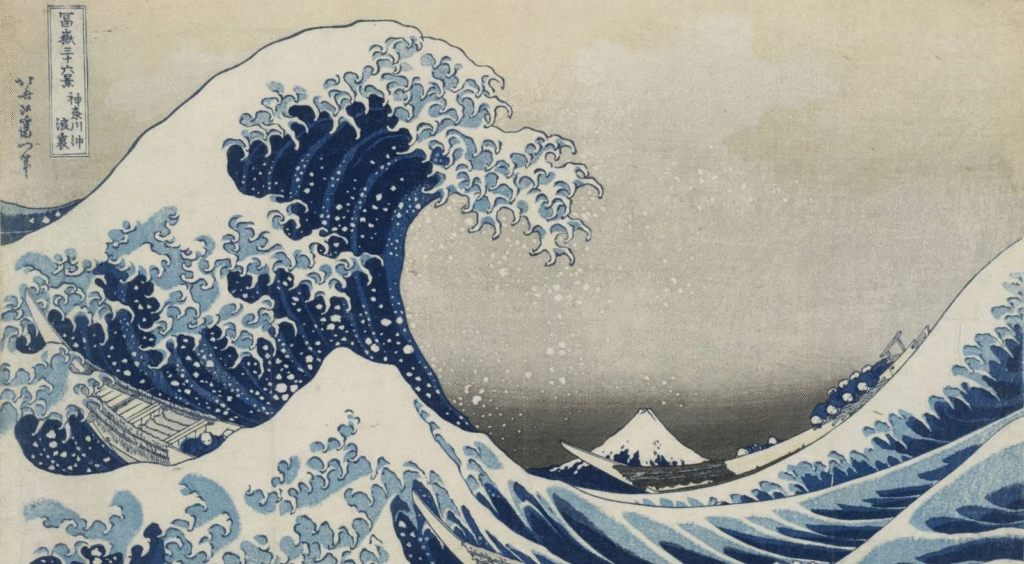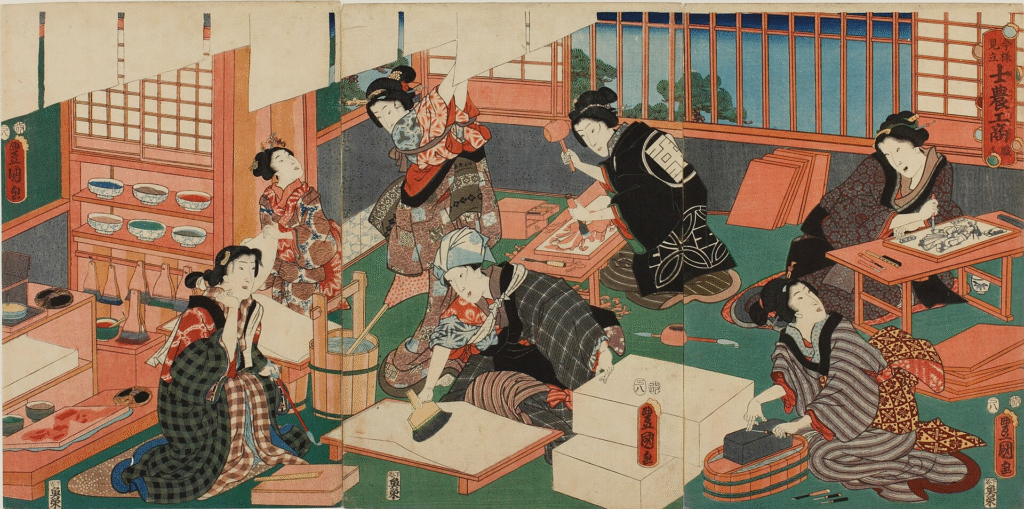When we think of Japanese art, few images are as instantly recognizable as the colorful, elegant prints of ukiyo-e (浮世絵). Depicting scenes of daily life, landscapes, beautiful courtesans, and theatrical performances, ukiyo-e offers a vibrant window into the cultural soul of Edo-period Japan (1603–1868).
But what exactly is ukiyo-e? How did it originate, what techniques does it involve, and why has it captivated audiences worldwide for centuries?
In this guide, we will explore the meaning, history, and artistic brilliance behind ukiyo-e, providing a rich cultural context for newcomers and seasoned art enthusiasts alike.
The Meaning Behind the Name “Ukiyo-e”
The word ukiyo-e is composed of three kanji characters: 浮 (uki, meaning “floating”), 世 (yo, meaning “world”), and 絵 (e, meaning “picture” or “painting”).
Originally, “ukiyo” referred to the Buddhist concept of the ephemeral nature of life—a melancholy reflection on human impermanence. However, by the Edo period, ukiyo evolved into a more cheerful and hedonistic meaning, referring to the urban pleasures of the merchant class: entertainment, fashion, romance, and leisure.
Thus, ukiyo-e literally means “pictures of the floating world,” celebrating fleeting beauty and joyful moments rather than lamenting them.
A Brief History of Ukiyo-e
Origins: The Rise of the Merchant Class
In the early 17th century, Japan entered a long period of peace and stability under the Tokugawa shogunate. Urban centers like Edo (modern-day Tokyo), Kyoto, and Osaka flourished, giving rise to a wealthy merchant class with newfound leisure time and disposable income.
These city dwellers craved art that reflected their interests: kabuki theater, tea houses, fashionable courtesans, seasonal festivals, and travel. Unlike the aristocratic and highly formal ink paintings of earlier eras, ukiyo-e offered accessible, affordable, and relatable art to a broad audience.
The Woodblock Printing Revolution
While early ukiyo-e works were hand-painted, technological innovations in woodblock printing (mokuhanga, 木版画) revolutionized the field. Artists would design the image, but skilled carvers and printers played crucial roles in transferring these designs onto paper, allowing for multiple copies to be produced.
This process democratized art ownership, enabling everyday citizens to decorate their homes with stunning, mass-produced images at reasonable prices.
Key Themes in Ukiyo-e

Ukiyo-e covers a wide range of themes, often categorized into several major genres:
- Bijin-ga (美人画): Pictures of beautiful women, highlighting contemporary fashion trends and ideals of beauty.
- Yakusha-e (役者絵): Portraits of kabuki actors, often dramatized with exaggerated facial expressions and poses.
- Meisho-e (名所絵): Depictions of famous scenic spots, particularly travel destinations like Mount Fuji or the Tōkaidō Road.
- Shunga (春画): Erotic prints, candid and often humorously explicit.
- Kachō-ga (花鳥画): Images of flowers and birds, blending naturalism with stylized elegance.
Each genre reflects not only artistic ingenuity but also the shifting tastes and values of Edo society.
Legendary Ukiyo-e Artists You Should Know
Several masters elevated ukiyo-e to global fame:
- Hishikawa Moronobu (菱川師宣): Often considered the founder of ukiyo-e, he pioneered early narrative prints.
- Kitagawa Utamaro (喜多川歌麿): Renowned for his delicate portraits of women.
- Toshusai Sharaku (東洲斎写楽): Celebrated for his expressive and dynamic kabuki actor prints.
- Katsushika Hokusai (葛飾北斎): Creator of the iconic The Great Wave off Kanagawa, Hokusai pushed ukiyo-e into landscape art.
- Utagawa Hiroshige (歌川広重): Famous for his lyrical landscapes, particularly The Fifty-three Stations of the Tōkaidō.
These artists did not merely depict life; they stylized it, offering dreamlike, idealized visions of a fleeting world.
The Global Legacy of Ukiyo-e
By the mid-19th century, Japan reopened to international trade after centuries of isolation. Ukiyo-e prints found eager audiences in Europe, profoundly influencing Impressionist and Post-Impressionist painters such as Van Gogh, Monet, and Degas.
This phenomenon, known as Japonisme, sparked a major movement in Western art and design, where the bold lines, flattened perspectives, and focus on everyday subjects seen in ukiyo-e redefined modern aesthetics.
Today, ukiyo-e continues to inspire artists, designers, and cultural enthusiasts worldwide. Its influence can be seen in everything from manga and anime to contemporary fashion and graphic design.
How to Experience Ukiyo-e Today

- Visit museums: Major institutions like the Tokyo National Museum, the British Museum, and the Metropolitan Museum of Art boast extensive ukiyo-e collections.
- Explore digital archives: Many historical ukiyo-e prints are available online for free. Notably, resources like the Internet Archive provide access to rare collections, including design-specific compilations like the Ukiyo-e Pattern Free Download.
- Collect reprints: High-quality reproductions allow art lovers to own and appreciate ukiyo-e works without breaking the bank.
Ukiyo-e: A Living Art Form Beyond Time
Far more than quaint images of an old Japan, ukiyo-e captures the vibrant, stylish, and evolving spirit of an era. Through the delicate artistry of woodblock printing, everyday moments—whether a moonlit stroll, a kabuki performance, or the bloom of a spring flower—are immortalized for all time.
As you explore resources like the Ukiyo-e Pattern Free Download, remember that each design carries the heartbeat of a once-floating, now-eternal world.
Thank you!





